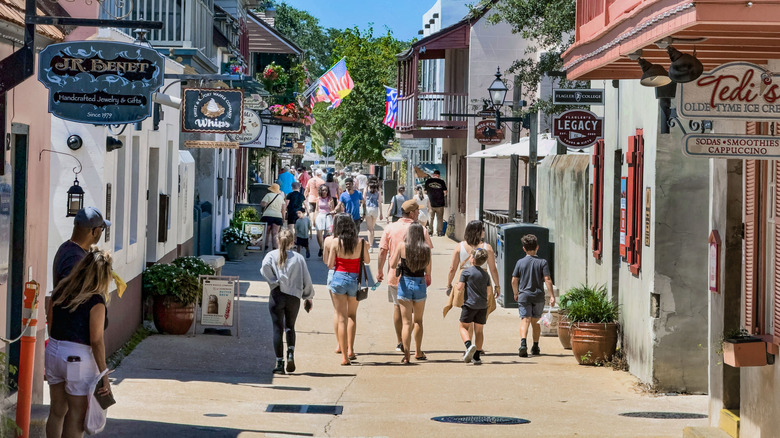This Underrated City In Florida Is A Historic Gem Full Of Coastal Charm
Florida is known for its theme parks and extensive coastline, but it's easy to forget the history of the peninsular state. Thankfully, sitting along the Atlantic coast is a city that not only draws in tourists for its beautiful beaches and sunrises, but also for its history: St. Augustine. The oldest continuously occupied city in the United States, it rests right alongside sandy shores that could easily pass for the tranquil blue beaches of the Caribbean.
Founded in 1565 by Spanish explorer Don Pedro Menéndez de Avilés, St. Augustine began as a military outpost. Today, the destination is a subtropical city that celebrates its heritage through preservation and education. Its well-kept historic district, surrounding the popular St. George Street, still boasts the cobblestones laid there centuries ago. Meanwhile, the country's oldest wooden schoolhouse — dating to the early 1800s — sits along the narrow street, showcasing what life was like for residents, students, and teachers in the United States' early days.
Perhaps the most iconic, if not largest, historic attraction in St. Augustine is the Castillo de San Marcos (pictured above). This fort, built between 1672 and 1695, was constructed with coquina — a mixture of sand, silt, and seashells. The immense structure withstood many attacks thanks to its impenetrable construction, and also served as a military prison during the Revolutionary War. Today, the fort is open for self-guided and guided tours, and has become a popular stop for many ghost tour groups.
Charm and atmosphere come together in St. Augustine
St. Augustine's unique history is preserved in what considered one of the best historic districts in America. Here, the streets are lined with homes and buildings that blend architectural styles from Spanish, Moorish, and American influences. Today, many of these properties are home to restaurants, bars, shops, and art galleries that bring in visitors looking for one-of-a-kind treasures. Overall, more than 1,600 buildings in St. Augustine are deemed historically significant — making the city a significant archeological site, as well as a popular tourist destination
The historic district and its many attractions sit just across the street from the Castillo de San Marcos, passing through what remains of the city's historic gates. Constructed in 1808 out of the same coquina bricks used on the fort, the two pillars that stand today were designed as a final line of defense for the coastal city.
Outside of its historic importance, visitors to St. Augustine will also enjoy a variety of natural and cultural attractions. For one, St. Augustine Beach stretches more than 40 miles and offers a variety of experiences. Meanwhile, Anastasia State Park, just 4 miles from the historic district, sits on its own island and is full of hiking and bicycle trails, picnic areas, and canoe rental opportunities. On the north end of the island, you'll find the iconic St. Augustine Lighthouse, which provides history and ghost tours throughout the year — all while continuing to alert ships in the Atlantic of the approaching shore. Finally, less than 2 mies away, the Fountain of Youth Archeological Park is where explorer Ponce de Leon landed in 1513, searching for an elixir that could provide eternal youth.
Visiting museums, beaches, and historic inns
St. Augustine is an ideal location for tourists looking to immerse themselves in both beach life and history. With mild temperatures throughout the year, exploring the city's many offerings is easy. Museums here uncover history, art, culture, and more unconventional subjects. The Medieval Torture Museum, for example, welcomes guests for a darker look at some of history's more disturbing moments. Meanwhile, the Pirate Treasure Museum celebrates maritime history with over 800 artifacts, including one of only two remaining original Jolly Roger flags. Nearby, housed within the former Hotel Alcazar, the Lightner Museum incorporates art, music, and interactive displays into a captivating experience for visitors of all ages.
Choosing accommodations in St. Augustine depends on your personal preferences. A number of historic inns offer romantic and secluded getaways just steps away from the historic district, while modern hotel chains offer rooms and amenities suitable for families. Fans of the outdoors can even book campsites for tent or RV camping at nearby Anastasia Park or Faver-Dykes State Park.
While St. Augustine may feel like a step back into the history books, reaching it is easy with modern transportation. Jacksonville International Airport (JAX) is just 56 miles to the north, while Orlando International Airport (MCO) is about 120 miles southwest, making it about a two-hour drive journey for tourists visiting the Sunshine State's many theme parks. It also sits squarely along the A1A Scenic and Historic Coastal Byway, an ocean drive lined with parks and galleries that accesses multiple beach towns in northeast Florida.


